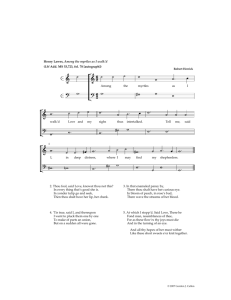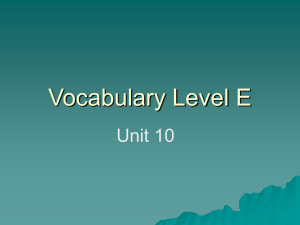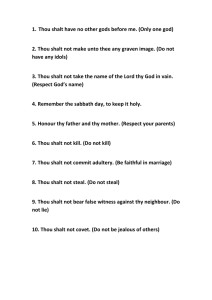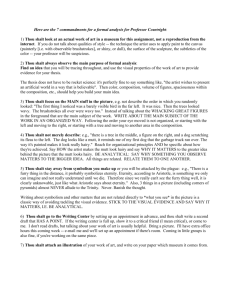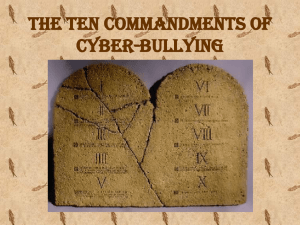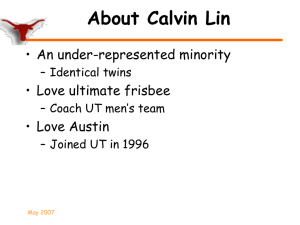CMSC 601: Giving Effective Presentations Adapted from slides by
advertisement
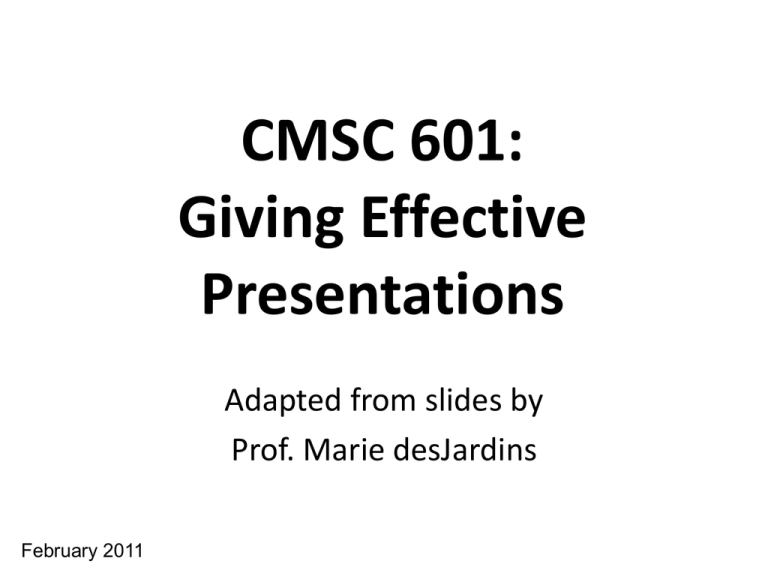
CMSC 601: Giving Effective Presentations Adapted from slides by Prof. Marie desJardins February 2011 Sources • Robert L. Peters, Getting What You Came For: The Smart Student’s Guide to Earning a Master’s or Ph.D. (Revised Edition). NY: Farrar, Straus, and Giroux, 1997. • Justin Zobel, Writing for Computer Science: The Art of Effective Communication, 2/e. London: SpringerVerlag, 2004. • Mark D. Hill, “Oral presentation advice” • S. L. Peyton Jones, J. Hughes, and J. Launchbury, “How to give a good research talk” (slides) • Patrick Winston, “Some lecturing heuristics” • Dave Patterson,How to have a bad career in research/academia” Outline • Rules for presentations • General guidelines for preparing talks • Paper presentation guidelines for this class The Rules • Rule #1: Know what on earth you’re doing up there! • Rule #2: Know what you want to say • Rule #3: Know your audience • Rule #4: Know how long you have Rule #2: Know What You Want to Say • Just giving a project summary is not interesting to most people • Give enough detail to get your interesting ideas across and show that you’ve actually solved the problem, but not enough to lose your audience • They want to hear what you did that was cool and why they should care • Preferably, they’ll hear the above two points three times: at the beginning of the talk, over the course of the talk, and at the end of the talk • If intrigued, they’ll ask questions or read your paper • Whatever you do, don’t just read your slides! Rule #3: Know Your Audience • Don’t waste time on basics if you’re talking to an audience in your field • Even for these people, you need to be sure you’re explaining each new concept clearly • On the other hand, you’ll lose people in a general audience if you don’t give the necessary background • In any case, the most important thing is to emphasize what you’ve done and why they should care! Rule #4: Know How Long You Have • How long is the talk? • Are questions included? – Will they come at the end or during the talk or both? • If you have too many slides, you’ll skip some or worse, rush desperately to finish. Avoid this temptation!! • Almost by definition, you never have time to say everything about your topic, so don’t worry about skipping some things! Rule #4: Know How Long You Have • How long will it take? • A good heuristic is 2-3 minutes per slide • Unless you’re very experienced giving talks, you should practice your timing – A couple of times on your own to get the general flow – At least one dry run to work out the kinks – A run-through on your own the night before the talk • Practicing move the content into your mind Comments on Zobel / Peters • Zobel recommends one minute per slide – Unless you have VERY little information on each slide, this is a racing speed • Peters recommends writing out your presentation, word for word – This is a very bad idea for most people, and will lead to extremely stilted delivery – The only alternative, if you’re not an experienced public speaker, is to PRACTICE – You want it in your mind, not just on your slides or on paper Organizing a Talk Talks are linear and only you control movement –Your audience can’t flip back to see what you said last or forward to see how close the end is –They can’t use the section headers as a guideline • Help them keep track of where you are in the talk with a reoccurring outline or some other device • Don’t try to cover as much ground as you would in a technical paper Organizing a Talk • Give an overview and use it throughout • Start with a slide or two on key ideas/contributions • Give a high-level summary (or simple example) before you dive down into (not too many) details • Recap at the end Slideology 101 • Don’t just read your slides! • Use the minimum amount of text necessary • Use examples • Use a readable, simple, yet elegant format • Use color to emphasize important points, but avoid the excessive use of color • “Hiding” bullets like this is annoying (but sometimes effective), but… Abuse of animation is • Don’t fidget, and… • Don’t just read your slides! a cardinal sin! How to Give a Bad Talk 1. Thou shalt not be neat 2. Thou shalt not waste space 3. Thou shalt not covet brevity 4. Thou shalt cover thy naked slides 5. Thou shalt not write large 6. Thou shalt not use color 7. Thou shalt not illustrate 8. Thou shalt not make eye contact 9. Thou shalt not skip slides in a long talk 10.Thou shalt not practice Advice from Dave Patterson, summarized by Mark Hill Handling Questions • Questions during the talk: – If your presentation will answer the question later, say so and move on – If your presentation won’t answer it, either give a brief answer or defer it to the end of the talk • Make sure you understand it before answering – Ask for clarification if you need it – Restate the question, and ask whether you’ve gotten it right • Have backup slides for questions you can anticipate but don’t have time for in the main presentation
